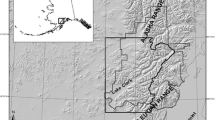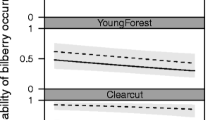Abstract
Although well known as carnivores and not capable of digesting plant fiber, grizzly bears (Ursus arctos horribilis) consume over 200 species of plants and are entirely vegetarian in some ecosystems. Even in ecosystems with abundant meat resources, green vegetation can be an important seasonal food resource. Therefore, we examined the morphological, physiological, and environmental constraints that determine the nutritional value of herbaceous vegetation to grizzly bears. Short-term, board foraging trials were used with captive grizzly bears to determine constraints on intake rate including bite size, bite rate, bear size, plant species, plant height, and plant distribution. Feeding trials were conducted to determine the effect of protein level (12–35%) and digestible dry matter intake on weight gain. Finally, maximum daily intake, daily foraging time, and weight change were measured for captive bears foraging on highly abundant and nutritious forbs and grasses during 12-day trials. Intake during short-term board trials overestimated the intake of freely foraging bears from two- to seven-fold depending on bear size. Because of their relatively larger bite sizes, smaller absolute energy requirements, and relatively larger intake capacity, smaller bears (<120 kg) made greater weight gains than very large bears on herbaceous vegetation. Smaller bears with ad libitum access to palatable, nutritious forbs gained weight at rates equal to wild bears. However, depending upon plant characteristics, bite sizes and available daily foraging time increasingly prevented large bears (>120 kg) from gaining weight on herbaceous vegetation. Both captive and wild bears select forbs over grasses at similar growth stages because forbs are generally higher in protein and more digestible than grasses. Therefore, the nutritional well-being of wild grizzly bears could be improved in areas where bears are largely herbivorous and, thus, relatively small by purposefully managing for nutritious forbs.
Similar content being viewed by others
Author information
Authors and Affiliations
Additional information
Electronic Publication
Rights and permissions
About this article
Cite this article
Rode, K., Robbins, C. & Shipley, L. Constraints on herbivory by grizzly bears. Oecologia 128, 62–71 (2001). https://doi.org/10.1007/s004420100637
Received:
Accepted:
Published:
Issue Date:
DOI: https://doi.org/10.1007/s004420100637




